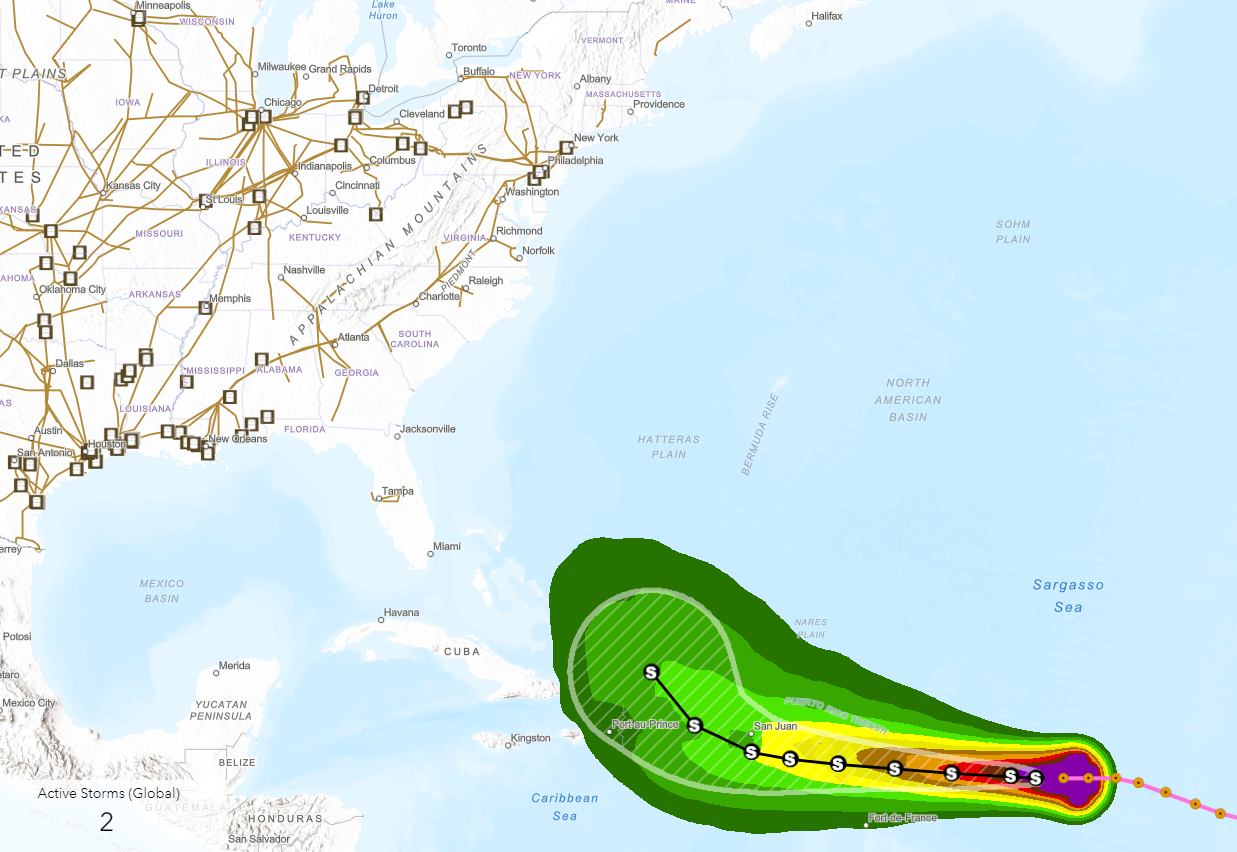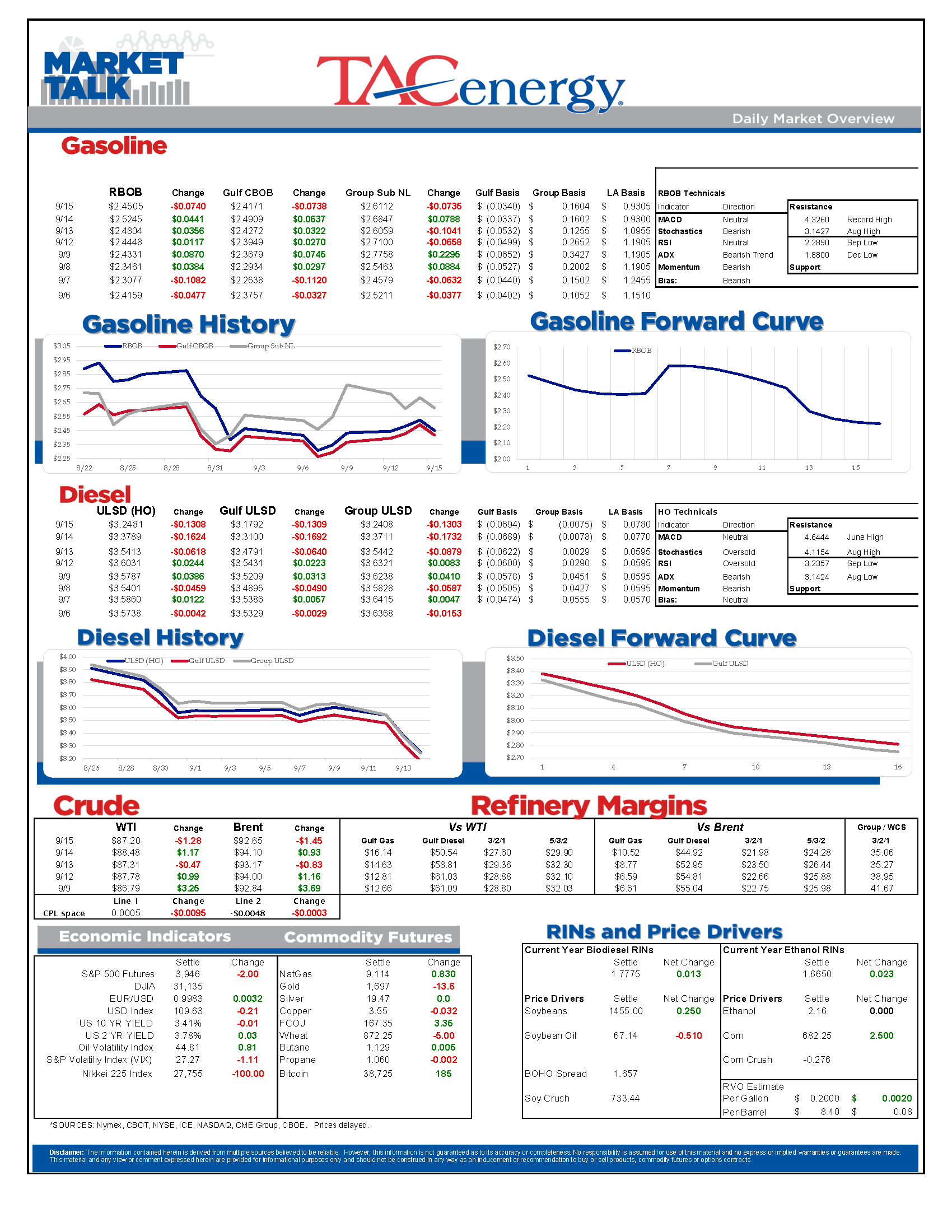Diesel Prices Have Dropped 45 Cents From Monday’s High

Diesel prices have dropped 45 cents from Monday’s high as demand concerns both domestically and globally are putting heavy downward pressure on prices, and RBOB and WTI are now joining in on the selling after resisting the pull lower Wednesday. ULSD futures are still more than 10 cents higher than their August lows, but look like they could make a run at those levels soon, with a move below $3 likely if that support breaks.
Some suppliers will be breathing easier this morning after reports that a “tentative deal” was reached to avert a nationwide railroad strike that could have created chaos in numerous commodity markets. Ethanol supplies in particular were troubling many suppliers this week as it could have left many terminals with plenty of gasoline in the tank, and yet no E10 available to sell at the rack, in addition to numerous concerns about Biodiesel and DEF supplies nationwide. Watch the price reaction in the grain, renewables and RIN markets today to see whether or not the market believes this deal will actually make it to reality.
The European Commission proposed an emergency energy market intervention plan Wednesday that includes mandatory reductions in demand for member countries, a cap on electricity prices from renewable, nuclear and coal sources, and a “temporary solidarity contribution on excess profits” for oil and gas sectors that somewhat like a Soviet-style solution to the Russian energy problem. The plan did not include a price cap on Russian energy purchases as had been previously proposed.
The IEA highlighted how Chinese lockdowns are leading a slump in global energy demand, but noted that demand is still growing, just not as fast as it was expected to this year. The monthly report also noted that EU embargos on Russian oil have not yet come into effect, and will do so just in time for the coordinated SPR releases to come to an end, leaving markets susceptible to new price spikes. The report highlights the specific concerns around distillate supplies, as Europe still does not have a solution for the 600mbday of Russian diesel it will stop importing this winter, and refinery capacity constraints severely limit their options.
Wednesday’s DOE report showed a large build in US Commercial crude inventories, but total oil stocks including the SPR declined, proving the IEA’s point that supplies may not look so strong once the record releases come to an end in two months. US crude oil output has stagnated over the past two months as labor logistical challenges continue to limit the growth in production. The report estimated that US diesel demand dropped by 13% to its lowest level of the year last week, which certainly isn’t helping encourage any buyers to step in at these lower levels, even though most PADDs have inventories well below normal levels.
Want to understand why California gasoline prices surged by more than $1/gallon last week? Take a look at the PADD 5 gasoline stocks chart below. Also note the huge decline in Midwestern (PADD 2) gasoline stocks the past 2 weeks as regional refiners have struggled to stay online, and shows how important the RVP waivers issues after BP’s refinery went offline were to avoid a price spike like we’ve seen on the West Coast.
Tropical storm Fiona was named overnight, and most models continue to suggest the storm will turn north by Monday and not threaten the Gulf of Mexico, making it a non-event for energy supplies. Most models keep this storm moving away from the East Coast as it moves north, but a few suggest that a landfall near the Carolinas is possible next week.
Latest Posts
The Sell-Off Continues In Energy Markets, RBOB Gasoline Futures Are Now Down Nearly 13 Cents In The Past Two Days
Week 15 - US DOE Inventory Recap
Prices To Lease Space On Colonial’s Main Gasoline Line Continue To Rally This Week
Equity Markets Have Been Pulling Back Sharply In Recent Days As Inflation And Trade Concerns Inject A Sense Of Reality Into Stocks
Social Media
News & Views
View All
The Sell-Off Continues In Energy Markets, RBOB Gasoline Futures Are Now Down Nearly 13 Cents In The Past Two Days
The sell-off continues in energy markets. RBOB gasoline futures are now down nearly 13 cents in the past two days, and have fallen 16 cents from a week ago, leading to questions about whether or not we’ve seen the seasonal peak in gasoline prices. ULSD futures are also coming under heavy selling pressure, dropping 15 cents so far this week and are trading at their lowest level since January 3rd.
The drop on the weekly chart certainly takes away the upside momentum for gasoline that still favored a run at the $3 mark just a few days ago, but the longer term up-trend that helped propel a 90-cent increase since mid-December is still intact as long as prices stay above the $2.60 mark for the next week. If diesel prices break below $2.50 there’s a strong possibility that we see another 30 cent price drop in the next couple of weeks.
An unwind of long positions after Iran’s attack on Israel was swatted out of the sky without further escalation (so far anyway) and reports that Russia is resuming refinery runs, both seeming to be contributing factors to the sharp pullback in prices.
Along with the uncertainty about where the next attacks may or may not occur, and if they will have any meaningful impact on supply, come no shortage of rumors about potential SPR releases or how OPEC might respond to the crisis. The only thing that’s certain at this point, is that there’s much more spare capacity for both oil production and refining now than there was 2 years ago, which seems to be helping keep a lid on prices despite so much tension.
In addition, for those that remember the chaos in oil markets 50 years ago sparked by similar events in and around Israel, read this note from the NY Times on why things are different this time around.
The DOE’s weekly status report was largely ignored in the midst of the big sell-off Wednesday, with few noteworthy items in the report.
Diesel demand did see a strong recovery from last week’s throwaway figure that proves the vulnerability of the weekly estimates, particularly the week after a holiday, but that did nothing to slow the sell-off in ULSD futures.
Perhaps the biggest next of the week was that the agency made its seasonal changes to nameplate refining capacity as facilities emerged from their spring maintenance.
PADD 2 saw an increase of 36mb/day, and PADD 3 increased by 72mb/day, both of which set new records for regional capacity. PADD 5 meanwhile continued its slow-motion decline, losing another 30mb/day of capacity as California’s war of attrition against the industry continues. It’s worth noting that given the glacial pace of EIA reporting on the topic, we’re unlikely to see the impact of Rodeo’s conversion in the official numbers until next year.
Speaking of which, if you believe the PADD 5 diesel chart below that suggests the region is running out of the fuel, when in fact there’s an excess in most local markets, you haven’t been paying attention. Gasoline inventories on the West Coast however do appear consistent with reality as less refining output and a lack of resupply options both continue to create headaches for suppliers.

Week 15 - US DOE Inventory Recap

Prices To Lease Space On Colonial’s Main Gasoline Line Continue To Rally This Week
Energy markets are sliding lower again to start Wednesday’s trading as demand concerns and weaker stock markets around the world seem to be outweighing any supply concerns for the time being.
Rumors continue to swirl about an “imminent” response by Israel to Iran’s attacks, but so far, no news seems to be taken as good news in the hopes that further escalation can be avoided, even as tensions near the Red Sea and Strait of Hormuz continue to simmer.
Prices to lease space on Colonial’s main gasoline line continue to rally this week, trading north of 11 cents/gallon as Gulf Coast producers still struggle to find outlets for their production, despite a healthy export market. Gulf Coast CBOB is trading at discounts of around 34 cents to futures, while Gulf Coast RBOB is trading around a 16-cent discount, which gives shippers room to pay up for the linespace and still deliver into the East Coast markets at a profit.
Back to reality, or just the start of more volatility? California CARBOB basis values have dropped back to “only” 40 cent premiums to RBOB futures this week, as multiple flaring events at California refineries don’t appear to have impacted supply. The state has been an island for fuel supplies for many years as its boutique grades prevent imports from neighboring states, and now add the conversion of the P66 Rodeo refinery to renewable diesel production and the pending changes to try and cap refinery profits, and it’s easier to understand why these markets are increasingly vulnerable to supply shocks and price spikes on gasoline.
RIN prices continue to fall this week, touching 44 cents/RIN for D4 and D6 values Tuesday, their lowest level in 6 weeks and just about a nickel above a 4-year low. While the sharp drop in RIN and LCFS values has caused several biodiesel and Renewable Diesel producers to either shut down or limit production, the growth in RIN generation continues thanks to projects like the Rodeo refinery conversion, making the supply in RINs still outpace the demand set by the Renewable Fuel Standard by a wide margin.
The API reported draws in refined products, 2.5 million barrels for gasoline and 427,000 barrels for distillates, while crude oil stocks had an estimated build of more than 4 million barrels. The DOE’s weekly report is due out at its normal time this morning.
Click here to download a PDF of today's TACenergy Market Talk.

